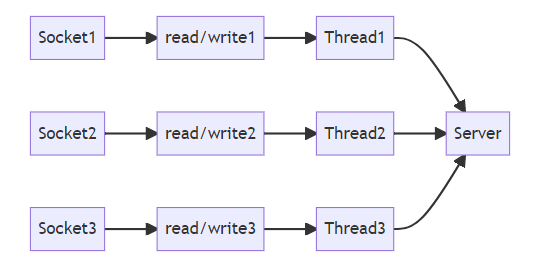Java BOI与NIO超详细实例精讲
顽石九变 人气:0Java BIO
阻塞IO,每个客户端链接都需要一个独立的线程处理,客户端链接没关闭时,线程链接处于阻塞状态,直到客户端链接关闭
如果客户端链接没有读取到数据,链接就会一直阻塞住,造成资源浪费

示例代码
开发一个ServerSocket服务端,通过telnet链接发送信息
import java.io.IOException;
import java.io.InputStream;
import java.net.ServerSocket;
import java.net.Socket;
import java.util.concurrent.ExecutorService;
import java.util.concurrent.Executors;
public class BIOServerTest {
public static void main(String[] args) throws Exception {
ExecutorService pool = Executors.newCachedThreadPool();
ServerSocket serverSocket = new ServerSocket(8888);
System.out.println("服务端启动");
while (true) {
System.out.println("等待链接...");
Socket socket = serverSocket.accept();
pool.execute(() -> {
handler(socket);
});
}
}
private static void handler(Socket socket) {
try {
System.out.println("有一个客户端接入:" + Thread.currentThread().getName());
byte[] bytes = new byte[1024];
//通过socket 获取输入流
InputStream inputStream = socket.getInputStream();
//循环读取客户端发送的数据
while (true) {
System.out.println("等待读取数据...");
int read = inputStream.read(bytes);
if (read != -1) {
//输出客户端读取的数据
System.out.println("线程信息:" + Thread.currentThread().getName());
System.out.println(new String(bytes, 0, read));
} else {
break;
}
}
} catch (Exception e) {
e.printStackTrace();
} finally {
System.out.println("关闭client链接:" + Thread.currentThread().getName());
try {
socket.close();
} catch (IOException e) {
e.printStackTrace();
}
}
}
}通过telnet链接两个客户端,分别发送请求
从控制台打印信息可以看出每一个链接对应的线程都是独立的
等待链接...
有一个客户端接入:pool-1-thread-1
等待读取数据...
线程信息:pool-1-thread-1
aaa
等待读取数据...
线程信息:pool-1-thread-1
bbb
等待读取数据...
等待链接...
有一个客户端接入:pool-1-thread-2
等待读取数据...
线程信息:pool-1-thread-2
ccc
等待读取数据...
线程信息:pool-1-thread-2
ddd
等待读取数据...
Java NIO
非阻塞IO,通过Selector和Channel,实现一个线程维护多个链接
NIO有三大核心部分:Channel(通道),Buffer(缓冲区),Selector(选择器)
NOI是面向缓冲区编程的,数据读取到一个它稍后处理的缓冲区,需要时可在缓冲区中前后移动,增加的处理过程的灵活性,使用它可以提供非阻塞式的高伸缩性网络
NIO是通过事件驱动编程的,Selector会根据不同的事件,在各个通道上切换
Channel同时支持读写双向处理
Selector能够监测到多个注册的通到是否有事件发生,这样就可以只用一个线程去管理多个通道,也就是管理多个链接和请求。
只有在链接真正有读写事件发生时,才会进行读写,大大减少了系统开销,并且不必为每个链接创建一个线程

代码解读
- 当客户端链接时,会通过ServerSocketChannel得到SocketChannel
- 将SocketChannel注册到Selector上,一个selector上可以注册多个SocketChannel
- 通过socketChannel.register()方法注册
- 注册后返回一个SelectionKey,会和该Selector关联
- Selector监听select方法,返回有事件发生的通道的个数
- 进一步得到有事件发生的各个SelectionKey,通过SelectionKey反向获取SocketChannel
- 通过得到的channel完成业务处理
1)服务端代码
import java.net.InetSocketAddress;
import java.nio.ByteBuffer;
import java.nio.channels.SelectionKey;
import java.nio.channels.Selector;
import java.nio.channels.ServerSocketChannel;
import java.nio.channels.SocketChannel;
import java.util.Iterator;
public class NIOServer {
public static void main(String[] args) throws Exception {
ServerSocketChannel serverSocketChannel = ServerSocketChannel.open();
InetSocketAddress inetSocketAddress = new InetSocketAddress(7000);
serverSocketChannel.socket().bind(inetSocketAddress);
serverSocketChannel.configureBlocking(false);
Selector selector = Selector.open();
//注册客户端链接事件到selector
serverSocketChannel.register(selector, SelectionKey.OP_ACCEPT);
while (true) {
int select = selector.select(1000L);
if (select == 0) {
System.out.println("等待1秒,没有事件发生");
continue;
}
//监听到相关事件发生,读取SelectionKey集合,遍历处理所有事件
Iterator<SelectionKey> keyIterator = selector.selectedKeys().iterator();
while (keyIterator.hasNext()) {
SelectionKey key = keyIterator.next();
if (key.isAcceptable()) {
SocketChannel socketChannel = serverSocketChannel.accept();
System.out.println("客户端链接成功,生成一个sockeChannel " + socketChannel.hashCode());
//将socketChannel设置为非阻塞
socketChannel.configureBlocking(false);
//注册内容读取事件到selector,同时关联一个Buffer
socketChannel.register(selector, SelectionKey.OP_READ, ByteBuffer.allocate(1024));
}
if (key.isReadable()) {
SocketChannel channel = null;
try {
channel = (SocketChannel) key.channel();
ByteBuffer byteBuffer = (ByteBuffer) key.attachment();
int read = channel.read(byteBuffer);
System.out.println("读取到数据: " + new String(byteBuffer.array(), 0, read));
} catch (Exception e) {
if (channel != null) {
channel.close();
}
e.printStackTrace();
}
}
//手动从集合中移除当前的SelectionKey,防止重复操作
keyIterator.remove();
}
}
}
}2)客户端代码
import java.net.InetSocketAddress;
import java.nio.ByteBuffer;
import java.nio.channels.SocketChannel;
public class NIOClient {
public static void main(String[] args) throws Exception {
SocketChannel socketChannel = SocketChannel.open();
socketChannel.configureBlocking(false);
InetSocketAddress inetSocketAddress = new InetSocketAddress("127.0.0.1", 7000);
if (!socketChannel.connect(inetSocketAddress)){
while (!socketChannel.finishConnect()){
System.out.println("链接未完成,客户端不会阻塞....");
}
}
String str = "Hello,你好~~~";
ByteBuffer byteBuffer = ByteBuffer.wrap(str.getBytes());
socketChannel.write(byteBuffer);
System.in.read();
}
}
控制台输出
等待1秒,没有事件发生
等待1秒,没有事件发生
等待1秒,没有事件发生
等待1秒,没有事件发生
等待1秒,没有事件发生
客户端链接成功,生成一个sockeChannel 60559178
读取到数据: Hello,你好~~~
等待1秒,没有事件发生
加载全部内容